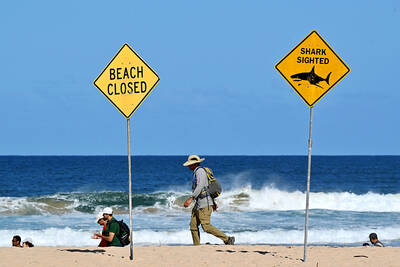The economic crisis raises the risk that European allies will pull back from Afghanistan at a time when US president-elect Barack Obama is expected to reach out to them for help, NATO’s supreme commander said on Friday.
At the same time, General Bantz Craddock predicted that US forces would be in Afghanistan for “at least” a decade, and likely have a presence there for decades to come.
His grim assessment comes as Obama prepares to shift the focus of US military operations to Afghanistan from Iraq to stem an insurgency that has rebounded over the past two years.
Craddock said that although European allies were expecting Obama to ask them to do more, “I think it’s going to be harder for them to do it because of decreasing defense budgets.”
He said NATO had plans for replacing Dutch forces in southern Afghanistan in 2010 and the Canadians in 2011.
“The unknown … is who else is going to pull out quickly. We don’t know that. It’s like in Iraq, when nations pulled out without telling anyone ahead time; it’s a terrible situation,” he told reporters.
The US has committed to sending an additional 30,000 US troops to Afghanistan, nearly doubling US force levels there from 32,000 troops currently.
But the pace of the US buildup has been slowed by continuing military requirements in Iraq, where there are still more than 140,000 troops and where commanders insist that conditions remain fragile.
In Afghanistan, the NATO-led International Security Assistance Force (ISAF) has about 50,000 troops, which includes 14,000 US troops.
Craddock said it would be another three years before the shortfall in security requirements there could be filled by the Afghan army, and so more foreign forces would be needed to provide security.
“We have to be able to implement our strategy: one, clear out the insurgency; two, hold; three, build,” he said.
However, he said that after clearing, “we don’t have enough to hold to allow the build.”
Asked whether Afghanistan would require a 10-year US military commitment, he said, “At least.”
“Maybe not at current force levels but I think we’ll see a presence there for decades,” he said.
The greatest security challenge is in southern Afghanistan, where ISAF faces a “very coherent Pashtun insurgency” fueled by the trade in drugs from Afghan poppies, Craddock said.
He said the UN estimated that insurgents were now getting US$200 million to US$500 million a year from the drug trade, a big jump from the previous UN estimate of US$60 million to US$100 million a year.
“The uptick in IEDs, the uptick in suicide bombs, the new numbers we’re seeing would tell me it has to be paid for,” he said, adding that he believed insurgent financing from drugs had at least doubled over the past year to 18 months.
Craddock has pushed for, and obtained, authority for ISAF to attack drug labs as a way of combating the insurgency.
“The question I’m asked all the time is, ‘are you losing?’” he said. “No. We’re not winning fast enough.”
He said European allies have not questioned the requirement for more forces in Afghanistan, but are constrained by declining defense budgets, and that is likely to get worse in current financial climate.
Currently, only six of 36 NATO members meet the alliance’s minimum goal of dedicating 2 percent of GDP to security, he said.
Of those, half have declining defense budgets, he said.
“Absent this financial crisis, still we’re challenged. With this financial crisis, we’re challenged ever more greatly,” he said.
Besides troop contributions to NATO operations, tight budgets are also undercutting efforts to modernize NATO forces and acquire helicopters, drones and other systems needed in Afghanistan, he said.
“So I think we are going to have some hard times ahead. It’s going to impact, one, the ability of nations to stay in operations, which is probably the most expensive. Two, it may slow down their transformation,” he said.

With much pomp and circumstance, Cairo is today to inaugurate the long-awaited Grand Egyptian Museum (GEM), widely presented as the crowning jewel on authorities’ efforts to overhaul the country’s vital tourism industry. With a panoramic view of the Giza pyramids plateau, the museum houses thousands of artifacts spanning more than 5,000 years of Egyptian antiquity at a whopping cost of more than US$1 billion. More than two decades in the making, the ultra-modern museum anticipates 5 million visitors annually, with never-before-seen relics on display. In the run-up to the grand opening, Egyptian media and official statements have hailed the “historic moment,” describing the

SECRETIVE SECT: Tetsuya Yamagami was said to have held a grudge against the Unification Church for bankrupting his family after his mother donated about ¥100m The gunman accused of killing former Japanese prime minister Shinzo Abe yesterday pleaded guilty, three years after the assassination in broad daylight shocked the world. The slaying forced a reckoning in a nation with little experience of gun violence, and ignited scrutiny of alleged ties between prominent conservative lawmakers and a secretive sect, the Unification Church. “Everything is true,” Tetsuya Yamagami said at a court in the western city of Nara, admitting to murdering the nation’s longest-serving leader in July 2022. The 45-year-old was led into the room by four security officials. When the judge asked him to state his name, Yamagami, who

DEADLY PREDATORS: In New South Wales, smart drumlines — anchored buoys with baited hooks — send an alert when a shark bites, allowing the sharks to be tagged High above Sydney’s beaches, drones seek one of the world’s deadliest predators, scanning for the flick of a tail, the swish of a fin or a shadow slipping through the swell. Australia’s oceans are teeming with sharks, with great whites topping the list of species that might fatally chomp a human. Undeterred, Australians flock to the sea in huge numbers — with a survey last year showing that nearly two-thirds of the population made a total of 650 million coastal visits in a single year. Many beach lovers accept the risks. When a shark killed surfer Mercury Psillakis off a northern Sydney beach last

‘CHILD PORNOGRAPHY’: The doll on Shein’s Web site measure about 80cm in height, and it was holding a teddy bear in a photo published by a daily newspaper France’s anti-fraud unit on Saturday said it had reported Asian e-commerce giant Shein (希音) for selling what it described as “sex dolls with a childlike appearance.” The French Directorate General for Competition, Consumer Affairs and Fraud Control (DGCCRF) said in a statement that the “description and categorization” of the items on Shein’s Web site “make it difficult to doubt the child pornography nature of the content.” Shortly after the statement, Shein announced that the dolls in question had been withdrawn from its platform and that it had launched an internal inquiry. On its Web site, Le Parisien daily published a